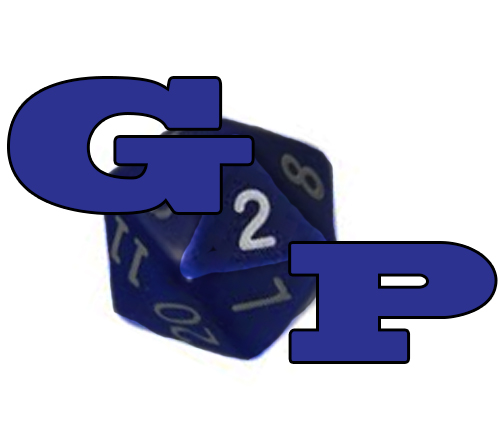
G2P (“Games 2 Play”) is a semi-regular editorial segment from GM Chris, and is devoted to showcasing the rare, the unusual, the crazy, the Indie, and (only very occasionally) the wildly popular in the tabletop RPG world. Games that you either didn’t know existed, games that you should try out as soon as you can, games that will make you laugh or hang your jaw in wonder at their amazeballs glory. In other words: games to play. This episode…
There are a lot of fandoms out there – most of which have been distilled by some publisher or another into a myriad of RPGs. The classic fandoms of fantasy, sci-fi, space opera, and horror paved the way for the initially-niche, now-exploded fandoms of cyberpunk, kung-fu action, steampunk, anime, trans-futurism, Cthulhu-mythos, and apocalypse survival. To be frank, I love them all. Maybe that’s why I love RPGs so much. But I’m also a huge lover of a fandom that’s often not categorized as a proper fandom – when it totally is.
Epitomized by the films of Tarantino and Mann, the graphic novels of Azzarello & Risso and Miller, it is the fandom of “modern-day competence mythology”: hyper-competent, unpleasant, violent people doing what they do best. Graphic Novels like 100 Bullets, or Sin City; films like Reservoir Dogs, Heat, Kill Bill (Vol 1, at any rate), The Bourne Identity, or any of the Bond films. The heroes – or should I say, anti-heroes – of these sources are the crux of the “competence mythology”, a mythology of extreme violence, character-focused storytelling, and anti-heroes. But really, it’s all about the anti-heroes.
These anti-heroes are better than anyone could even think about being, and they don’t even try. They just are. They dress well, like nice things, drive powerful cars, wear matching dark suits, use state-of-the-art firepower, and always take everything in stride. They drink tequila straight, wear sunglasses at night, smoke and never get cancer, and walk among the sheep of the world with impunity. They are the ultimate in bad-ass cool.
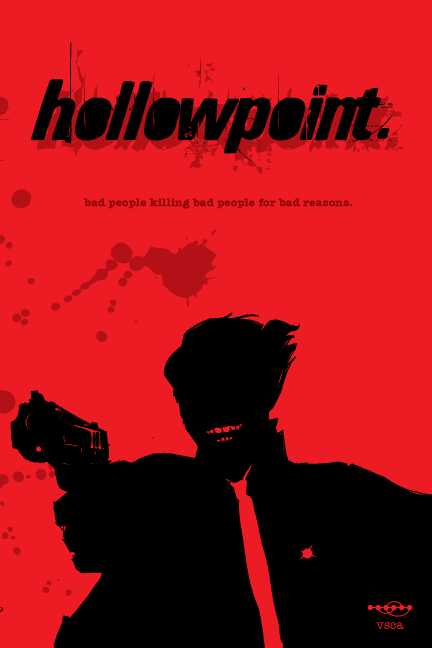
There have been more than a few RPG attempts to capture the modern-day “competence mythology”/anti-hero feel, and some have been quite decent. But after my good friend, GM Kat, introduced me to Hollowpoint, by Canadian-based VSCA Publishing, I can honestly say that few have captured the real feel of this fandom in a narrative sense – not like Hollowpoint has. Writers B. Murray and C.W. Marshall have tapped into a real understanding of the competence mythology, by picking up the ball where other games have dropped it.
Hollowpoint focuses not on the mechanics of shooting your way out of a bank heist, but on completing the heist. It’s a game that realizes hit points not only don’t matter for hyper-competent anti-heroes, but merely having them completely misses the point as these anti-heroes will often get shot 8 times in the chest with armor-piercing rounds, and still complete their mission before dying. It’s a game that understands that hyper-competent anti-heroes never count bullets or cash, but always have just what they need – until they lose it dramatically. And most importantly, Hollowpoint anti-heroes never, ever deal with sheep. If an “Agent” in Hollowpoint is messed with by the cops, it’s because someone with real power is using the police as pawns to hassle them; and if they are hauled in by the law, they instantly know the phone number to call that will get them released – with an apology. The bullets in their guns are not only untraceable – they stop investigations.
This is the world of Hollowpoint, perhaps the finest hyper-competence RPG I have ever played. Bad people doing bad things for bad reasons.

But a good story is NOTHING without conflict, and what conflict really exists for the hyper-competent Beatrix Kiddos and James Bonds of the world? What any fan of “competence mythology” will tell you is that conflict exists with other hyper-competents, not just villainous adversaries and megalomaniacal organizations, but (perhaps most importantly) fellow members of your own team. Hollowpoint focuses on this by being a game about necessary teamwork between people who don’t necessarily want to work in a team – and in some cases, resent it. But they have to, because that’s the job.
Hollowpoint can be run in varied hyper-competence settings, from ’80s California to Ancient Rome to Medieval Fantasy to Dieselpunk to G.I. JOE (the aforementioned brilliant GM Kat even ran a Magnum P.I. scenario, recently!). In any era, though, this is a world where our PCs play these hyper-competent anti-heroes as “Agents” who do what others cannot or do not. Their experiences and tricks define them, and they do daring, ultra-violent things that often end in a very messy way – for themselves as much as those in the way. In fact, character death – or “moving on” – is somewhat encouraged in Hollowpoint, as it not only provides a tremendous dramatic moment in the story, but gives the Player a chance to roll in a new “higher ranked” character. Each character is an “Agent” in some sense, depending on the setting; each works for an “Agency”, whatever that might be, with its own unique goals; and each session the Agents have a “Mission.” As long as these touch-points are met, any setting, style, or theme can work.
Character creation and management is the key aspect of the system, with very simple character creation (with a roll up time of about 5 minutes). Each character has ranks in six or so skills (some era-specific or theme-focused games, the GM – or “Ref” – might add an extra skill or two), but what’s important is that skills measure what your Agent does to other people. Core skills are things like KILL, TAKE, and COOL. An Agent might be a rocket scientist or a concert-level cellist or have seven Ph.D.s in ancient history – and in that case they just have those things. Those things aren’t skills in Hollowpoint. Each skill is ranked 0 to 5, from what you’re best at, to what you’re normal at. Most people have a zero in everything. A very well trained person might have a 1 in something; a Navy SEAL might have a 1 in KILL, or a true Zen Master might have a 1 in COOL. But even these exceptional people aren’t even in the same league as an Agent.
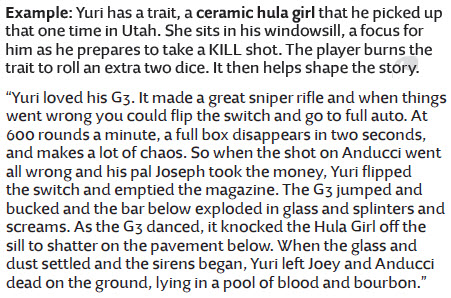
Agents also begin the game with five traits, the real soul of the character play experience. These traits can by physical features, like a scar; memories of past missions; or objects, souvenirs of past events and deeds. “Competence Mythology” anti-heroes always have these, from the cool scar that tells a story, to personal credo point you always follow, to the silver pendant that reminds you of a job gone wrong. Maybe it’s a bullet-wound over your heart after the fiasco in Budapest, or a ceramic hula girl you picked up that one time in Utah. It’s a memory. These Traits can be “burned” to offer a mechanical advantage in conflicts (rolling more dice), but can be burned by the player to make narrative declarations in the game. Each scar or souvenir tells a story – but no one wants to hear the same story twice (whether it’s your partners or the audience). So once a Trait is burned, it’s gone. Traits can be assigned on the fly, generated before the first mission by group narration and Q&A, or a mixture of both. Burned Traits are always replaced at the beginning of the next session, usually with something completely new – hopefully representing the mission just completed.
Lastly, each Agent – though a hyper-competent bad-ass – may create an optional Complication. Done after hearing the mission, it makes this mission personal in a way unknown to the other players, only to that player and the Ref. (There’s some player/Ref negotiation, of course, and the Ref is always able to veto a Complication). It should be big, interesting, relevant, and bad. The chick we need to assassinate is my girlfriend. The stash we’re supposed to steal – I already stole it and spent it on blow. We’re supposed to spy on Margaret Rhys-Davies and determine if she’s betrayed the Agency; but I’ve been screwing around with Margaret for months now, and the Agency doesn’t know.
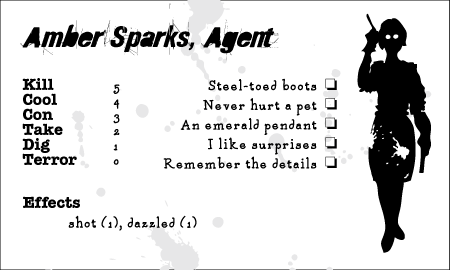

Gameplay centers around a premise of escalation; regardless of what is happening in a scene, each conflict is a bit harder for the players than the one before. Hollowpoint uses a dice pool system to resolve these conflicts, and each round of a scene, each player will commit an action and corresponding skill, rolling dice equal to their rank in that skill (perhaps more, by burning Traits). Within rolled results, players are looking for matching sets of dice – with each set having a length (the number of dice in the set) and a width (the number on the face of that set). So a roll of 2,3,3,3,5,5 leaves two sets: three threes and a pair of fives, or 3×3 and 2×5. The Ref rolls dice, too, which represent ALL of the threats in that scene. For the first conflict of the game, the Ref rolls 2 dice for every player at the table as his base pool. But every time the players succeed in a conflict (or flee the scene – which shouldn’t happen), the Ref amps up the next conflict by adding two dice to his base pool.
Sets are ranked against each player’s and the Ref’s sets, with longest, highest sets going first in the action. If you go first, you get to narrate whom you are targeting, and what your brought-to-bear skill means to the conflict – what you DO to that target. Ultimately, the hit target removes a die from her shortest, highest set. If a target ultimately has no sets, she gains an “effect”, which is bad. Each effect is determined by the player and the skill they used. KILL might lead to an effect of “Shot” (or “Cut”). CON might lead to an effect of “Marked”. If you take an effect when you already have one from the same skill, you get a second-stage effect, which is really bad. A “Shot” character might now be “Bleeding Out”, or the “Marked” character might now be “Suckered”. Characters who take a second-stage effect from the same skill can no longer participate in the conflict. They remain in the scene until it is over, or they chose to move on. (Another important feature of “competency mythology” – character death is always a player choice. You might get taken out of a scene, but only you decide if that’s the end for you.)
But more fun comes in with a limited group resource – the Teamwork Pool. At the start of the game, five dice are added to a bowl (or other separate area) in the middle of table for each character. And whenever a character moves on, and a new one is introduced, five dice to the Teamwork Pool come with them. These dice represent support from the team and the Agency they work for. Once per conflict, a player may ask for support from the team – before her dice are rolled. The player asking for support narrates why she deserves it, and who (of the other players) she’s leaning on to get it done. The kicker is that this player can say, “Okay”, and give his committed dice for the round to the player, assisting her roll. His action for the round is consumed, and he can’t be harmed this round. OR… he can say, “F$%k That”, actually taking two dice from the hand of the person asking for help. Calling for help makes you look weak and small, and no Agent wants to help a whiner. This stinks – but a player who’s been rejected THEN has the choice to take any number of dice from the Teamwork Pool to augment her roll. If you need help, ask – but you risk hurting the team (and the mission) long-term because you’re weak. Do you help if you are asked? Do you ask, thinking you’ll be rejected so you can raid the Teamwork Pool? How long can characters work together under extreme circumstances as a team? All of this puts a major pressure on teamwork – and this is a good thing that is at the heart of Hollowpoint‘s play mechanic and the “competence mythology” theme.
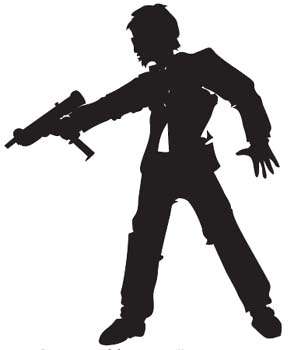
All of this (rather simple, in play) framework creates a highly narrative resolution mechanic that focuses on teamwork conflicts, character stories, and escalation. Additional minor mechanics also come into play. Rank Abilities, provided by your role as an Agent, allow you to perform special benefits for your team – but the best abilities are held by “higher ranked” Agents, and the only way to get a higher rank is to move on an introduce a brand new Agent character (who starts with a higher rank). The “Wash” rule ensures escalation and conflict by stating that if a round occurs where NO character took an effect or burned a Trait – ALL characters receive an effect from their own attacking skill (because if you don’t make things happen, the story will). There are several other easily manageable Ref tools to measure “timing” and staged success on a mission, as well.
All in all, Hollowpoint is a TIGHT and CLEAN experience, easy to learn, easy to teach, and extremely fun to play. I can count on two hands the number of RPGs I’ve played that give the gritty feel of “competence mythology” its proper due. And I can count on one hand the number of RPGs I’ve played where character stories and growth provide a simple, easily measurable impact in combative gameplay. Hollowpoint is a fast throw-down, an addictive PUG, and can make for a memorable short-term campaign. Play it. Please. I can’t recommend it enough. You can check out Hollowpoint from VSCA’s site, or just plop down the $10 for the PDF, directly from Indie Press Revolution (who also offers a PDF/soft cover combo for $20!).
Peace, Love, and Good Gaming – GMC
(All names, references, and pictures presented in this article are Copyright 2012 to VSCA Publishing, all rights reserved by their respective owners. This article is a media work of review and publicity, and is in no way intended to share intellectual property or copyrighted material outside the scope of media review.)
Latest posts by GM Chris (see all)
- New “Edge Studio” Will Take Over FFG RPGs - March 11, 2020

